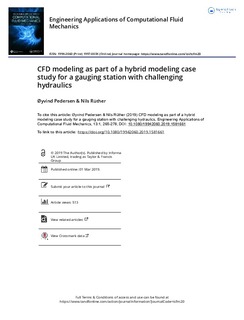| dc.contributor.author | Pedersen, Øyvind | |
| dc.contributor.author | Ruther, Nils | |
| dc.date.accessioned | 2019-10-07T13:40:13Z | |
| dc.date.available | 2019-10-07T13:40:13Z | |
| dc.date.created | 2019-05-30T21:51:51Z | |
| dc.date.issued | 2019 | |
| dc.identifier.citation | Engineering Applications of Computational Fluid Mechanics. 2019, 13 (1), 265-278. | nb_NO |
| dc.identifier.issn | 1994-2060 | |
| dc.identifier.uri | http://hdl.handle.net/11250/2620696 | |
| dc.description.abstract | Estimates of peak flood discharges are most often based on stage measurements, and the discharge is determined indirectly from the extrapolation of a rating-curve. It is possible to improve the extrapolation of the rating-curve by hydraulic modeling, such as scale or numerical models. In this paper, we discuss a case study for a streamflow gauging station in a mountainous river in Norway. A computational fluid dynamics model is used as part of a hybrid modeling study to study the flow at this gauging station with challenging geometry and flow and derive a reliable rating-curve. The numerical model produces stage-discharge data with comparable accuracy to the scale model. Analysis of the results of the hybrid modeling shows that the original location of stage measurements is not suitable for field measurements or for modeling the rating curve. Based on the modeling, an alternative point of measurement with better flow conditions at high flows is identified. The results and findings highlight the importance of 3-dimensional flow at the site during floods and shows how computational fluid dynamics can be used to provide stage-discharge data for rating curves and provide additional insight in hybrid modeling. | nb_NO |
| dc.language.iso | eng | nb_NO |
| dc.publisher | Taylor & Francis | nb_NO |
| dc.rights | Navngivelse 4.0 Internasjonal | * |
| dc.rights.uri | http://creativecommons.org/licenses/by/4.0/deed.no | * |
| dc.title | CFD modeling as part of a hybrid modeling case study for a gauging station with challenging hydraulics | nb_NO |
| dc.type | Journal article | nb_NO |
| dc.type | Peer reviewed | nb_NO |
| dc.description.version | publishedVersion | nb_NO |
| dc.source.pagenumber | 265-278 | nb_NO |
| dc.source.volume | 13 | nb_NO |
| dc.source.journal | Engineering Applications of Computational Fluid Mechanics | nb_NO |
| dc.source.issue | 1 | nb_NO |
| dc.identifier.doi | 10.1080/19942060.2019.1581661 | |
| dc.identifier.cristin | 1701662 | |
| dc.relation.project | Norges forskningsråd: FlomQ | nb_NO |
| dc.description.localcode | © 2019 The Author(s). Published by Informa UK Limited, trading as Taylor & Francis Group This is an Open Access article distributed under the terms of the Creative Commons Attribution License (http://creativecommons.org/licenses/by/4.0/), which permits unrestricted use, distribution, and reproduction in any medium, provided the original work is properly cited. | nb_NO |
| cristin.unitcode | 194,64,91,0 | |
| cristin.unitname | Institutt for bygg- og miljøteknikk | |
| cristin.ispublished | true | |
| cristin.fulltext | original | |
| cristin.qualitycode | 1 | |

